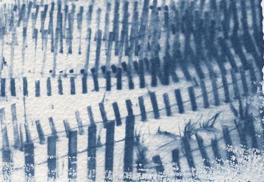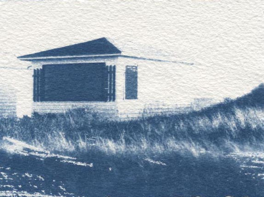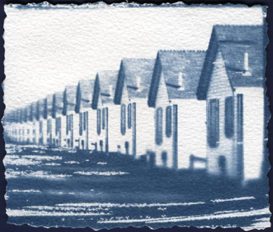CapeWomenOnline - Where Cape Women Shine
Your local venue for the women of Cape Cod to share their ideas, experiences and resources while inspiring each other in their life's journey
Inspire . Encourage . Network . Share

Harnessing The Power Of The Sun
Exploring the Art of Cyanotypes
by Rebecca Bruyn
The sun. How fantastic is it that the light we all take for granted can do so many things? It truly is an incredible resource. It is reliable, rising every day, creating heat and warmth, electricity and, of course, light.
As a photographer, one who uses the light to capture and develop my images, I'm always intrigued as to how it will impact an image not only when I take the photograph but when I print the image as well. Capturing the moment, capturing the light.

Cyanotypes are my main mode of photography. It's a hand-printed process, developed in the mid-1800's, using sunlight to develop the image.
Why cyanotypes?
In late 1990's, I became aware of a new form of photography, digital photography, and I was resistant to it. I wanted to find an alternative way of using a basic negative. At that time, using digital did not have the feeling I was looking for in making an image. For me, it was a two-dimensional technical process. I needed something more organic.
I was interested in preserving the past, or rather, not losing the process of photography we were using from the past. What I do now is called alternative photography.
In 1999, I met Midge Battelle, a well-known photographer in Provincetown, who was teaching cyanotype printing at the time. I saw her images and fell in love with them. I attended a weekend workshop, and she taught me the basics of creating cyanotypes using the two iron salt chemicals that are the basis for printing.
I learned how to make negatives from slides and once I got the hang of digital photography, I made negatives from digital images. And I was hooked. Cyanotypes, the precursor to "blue prints" are blue in color (cyan=blue) and evoke in the viewer a sense of looking back in time, similar to the sepia-toned photos from the 1800's.
The process:
- Create a negative and print it on a transparency.
- Prepare watercolor paper with the two chemicals using a paintbrush. This step needs to be done where there is no sunlight.
- Once the paper is dry, put the negative on top of the watercolor paper, and place a sheet of glass on top of the negative. Simple contact printing.
- Place the piece in direct sunlight and let it "bake" for several minutes.
- Once the image appears, rinse with water, dip in Hydrogen Peroxide, which gives it a pop, making the image a little darker. Then let it dry.
Depending on the process, the sunlight, the emulsion, the way the chemicals are painted on the watercolor paper, and the actual image itself, I never know exactly how it's going to come out. I don't control for density of color, light or dark, so there is definitely an element of surprise each time. Since I use a paintbrush that creates painted strokes of blue, each final image is unique.
What is my subject matter?
I photograph historic places on the Outer Cape, such as the Provincetown Monument, Truro's Highland House, Days Cottages or Highland Light. I am also drawn to architectural structures; buildings, doors and windows, and of course, landscapes and several sailboats of Cape Cod.
In 2010, I entered a juried competition to celebrate the 100th anniversary of the building of the Provincetown Pilgrim Monument. The competition and celebration were a collaboration between the monument and the Truro Vineyards of Cape Cod.
My entry, a cyanotype called "Monument Reflections" was selected and subsequently became the label art for a limited edition wine.
How do I plan my shots?
At times, I wander with my camera not knowing what I will photograph, and other times I plan what I want to take pictures of. If there's a particular place in my mind, I plan a shoot. For example, the light on Salt Pond in Eastham is stunning at certain times. It's on my list of places to photograph. But then there's the unexpected angle of the sun, suddenly appearing, and you know it's only for a brief moment.

A couple of years ago, I saw that moment at the Days Cottages, in North Truro. The sun was setting and casting shadows across the road so I pulled over and captured the light.
Ironically, in 2007, I was bitten by the "go green bug," and became immersed in energy efficiency/renewable energy. I started a neighborhood educational group, joined the town's Energy Committee, and attended Cape Cod Community College, receiving a certificate in solar technology in 2012.
As I became more aware of the power of the sun to create energy, I realized the critical role that the sun was playing in my life.
In fact, sunlight has recently become a more integral part in my daily life. We've just installed solar panels to help contribute clean energy to the grid. I placed a raised garden bed in the back yard for the first time and successfully planted vegetables in the summer sunlight. In warmer, sunnier weather, I use a clothesline for drying clothes.
It's an extraordinary phenomenon when you begin to realize the power of the sun and the many ways in which we use its energy and light. Since 1999, sunlight has been a central part of my life. Every day I am harnessing the power of the sun!
All artwork courtesy of the Cortile Gallery
Rebecca Bruyn is represented by Cortile Gallery in Provincetown and the Little Beach Gallery in Hyannis. You can contact her at rebcin@comcast.net or visit her website at www.rebeccabruyn.com.


